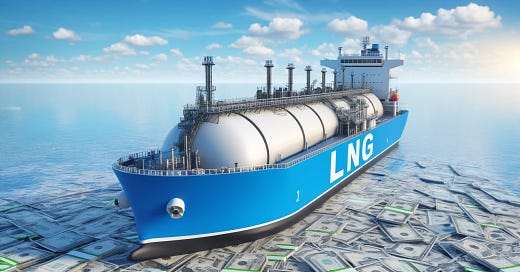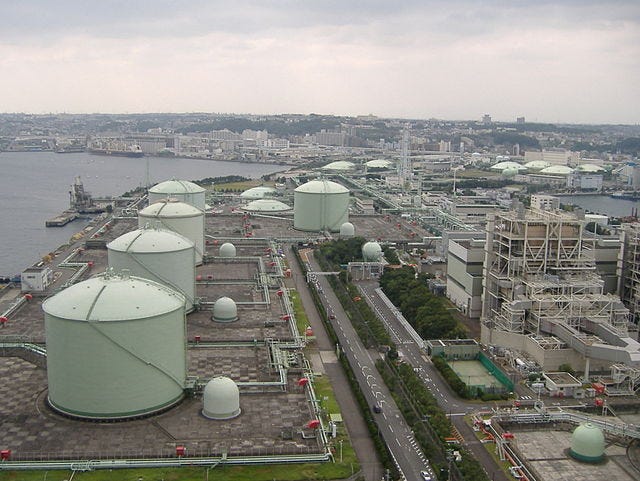From Zero to Hero... The Incredible Story of American LNG, Personified
Mezzaluna, Mr. Souki and the Journey to the Top
“If you keep digging, digging, digging, you find something.”
~ Charif Souki
O.J. Simpson died last month. Unless you've been living under a rock, you probably know that.
Well, I guess I sort of have been. I’d been busy working on the latest issue of Crisis Investing, so I only found out about it over the weekend. But, as I caught up on media reports about his "legacy,” I couldn't help but think about a different yet parallel story… and one that has important investment implications for us.
And that's the story of Charif Souki, an American restaurateur-turned-energy titan.
In the 90s, Charif owned an Italian restaurant in West L.A.'s Brentwood neighborhood. It was called Mezzaluna and, coincidentally, it was where Nicole Simpson had her last meal on June 12, 1994.
On that fateful night, Simpson's mother left her glasses there, so a waiter from the restaurant, Ron Goldman, went to Simpson's home to return them. Shortly after midnight, Goldman was found dead with Simpson outside her condo.
The Switch
After the murders, Mezzaluna was swarmed by reporters, photographers, and curious tourists. People bombarded employees for details, even asking about Simpson's final meal. Charif was appalled by the media frenzy – "the morbid curiosity, the lack of taste and decency of people, was pretty astonishing," he would later remark. It was then that he made the decision to sell Mezzaluna and venture into something new.
After some deliberating, he made the unlikely transition to the oil-and-gas industry.
His first big idea was to import cheap, plentiful natural gas from the Middle East in the form of liquefied natural gas, or LNG.
Note: Creating LNG involves cooling gas to -260 degrees Fahrenheit, which turns it into a liquid. This liquid takes up about one six-hundredth of the volume of its gaseous form, allowing it to be loaded onto tanker ships and transported across oceans.
But, to unload it for use in the U.S. market, you needed a gas processing plant (similar to the one below) that could "regasify" it and then pump it into domestic pipelines.
LNG was quite a novelty at the time, and there was no infrastructure in place.
Now, the reason I called Charif's move into energy unlikely earlier was because, at first glance, he had a lot stacked against him. He had no experience in oil or gas drilling, and the intricacies of the energy industry, from extracting hydrocarbons to their conversion into usable energy, seemed impossibly complex.
Yet, he still felt capable enough, regardless.
At the end of the day, he figured, people in the industry simply borrowed money, extracted fuel, and sold it. That’s simple enough. Why just not try and raise some cash and see how it goes?
So, he did.
Once again, it was a very new idea at the time. In fact, almost everyone Charif came across thought he was crazy.
Unfazed, he managed to raise $2 billion to make this big idea a reality. And it wasn’t long before he identified a site for his facility on a swampy section of the Louisiana-Texas border.
The Switcheroo
But there was just one problem. The timing.
In the late 2000s, as his terminal was nearly done, a group of energy tycoons pioneered innovative techniques for extracting gas from deep, inland shale layers. They called it hydraulic fracturing, or fracking. It had the potential to unlock vast amounts of natural gas, enough to keep America powered for centuries. It also made Souki's import terminal good for nothing but scrap.
A lesser man might have given up then and there, but Charif was no quitter.
He realized that fracking wasn’t just a solution to America’s energy problems; it was a solution to the world's. And it could make the U.S. the world’s leading producer of oil and gas.
So, he decided to reverse the process at his terminal, reworking it to liquefy the natural gas from fracking and get it ready for export on a global scale. Soon, he was on the hunt for investors again, trying to sell them on his idea.
This was no simple task. Turning natural gas into a liquid is way more complicated, costly and energy-intensive than the reverse.
And yet, Charif managed to raise an impressive $20 billion. Mind you, many of these investors had previously contributed to the financing and hadn't yet recouped their initial investment.
Long story short, the plan worked. It made Charif Souki the highest paid public company executive, earning $142 million in 2013.
Charif’s story is America’s journey – from exporting virtually no natural gas to becoming the world’s top LNG exporter in just six years. You can see this astonishing transformation in the chart below.
In 2023, the U.S. exported more LNG than any other country.
And it looks like this trend is here to stay.
The Energy Information Administration (EIA) forecasts U.S. natural gas exports will triple from 4.3 trillion cubic feet per year to about 12.75 trillion by 2033. Even if we don't put much faith in the government's numbers (though that's their base scenario) and cut that in half, it's still a 50% increase.
This is a huge opportunity for U.S. companies that produce and transport natural gas. And Doug Casey agrees:
Natural gas is hovering around US$1.90 per million British thermal units (MMBtu). That's close to its lowest level in history in real, inflation-adjusted, terms. And this comes at a time when its potential for explosive growth has never been greater.
Typically, natural gas has traded around US$3 per MMBtu over the span of a decade or two. But, in other parts of the world, especially in Europe, it sells for much higher, usually around US$12. Just a few years ago, it was around US$40. And given the challenges the EU is facing, it will likely reach that level again.
Regards,
Lau Vegys
P.S. Despite some ups and downs in the market, there's a growing demand from all around the world for cheap U.S. gas. And one factor driving even more of it is the increasing geopolitical instability. Stay tuned for Part 2 of my later this week, where I'll dig deeper into that.






Great story. Thanks!